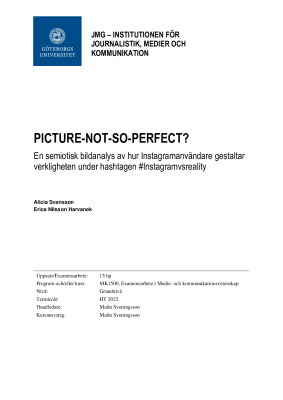PICTURE-NOT-SO-PERFECT?
En semiotisk bildanalys av hur Instagramanvändare gestaltar
verkligheten under hashtagen #Instagramvsreality
Executive summary
Social media has become a huge part of everyday life. With it, editing and manipulation of images to post online has increased. Several studies have proven that retouched images can have a great negative impact on people’s self image and mental health. Noticeable in previous
research is the fact that mainly teenage girls have a drive to pursue a slim body. The ones who are already insecure about themselves, are also more receptive to content with a negative impact.
What’s different with social media and the digital era is the possibility for everyone to be the message sender, or the message receiver. Meaning, everyone can target or be targeted with content about body ideals that can affect people differently. Body activism online usually
arises through a response to an event or happening. The past years, many movements have been given focus on Instagram through hashtags. The hashtag #Instagramvsreality came from a growing trend on social media to counteract the negative effects that comes with filters and editing. Posts containing the hashtag are meant to expose two sides of the same person — one from an idealized portrayal and the other from a more natural one.
The purpose of this study is to analyze images on Instagram published under the hashtag #Instagramvsreality based on how different broadcasters use the hashtag for body activism. Our aim is to examine whether the content associated with the hashtag differs depending on
the sender’s body size. To do so, we’ve carried out a semiotic image analysis inspired by Ronald Barthes’ theory on semiotics. He believes that our way of seeing the world is a matter of our history and experience, and the perspectives are divided into denotation; what we see, and connotation; how we interpret what we see. This was the reason for us beginning to speculate if the posted content online could differ, since the interpretation of ”reality” regarding the hashtag can differ depending on who we are.
Non normative bodies have shown to be exposed in images containing the hashtag. Although, not in a near amount the same as the people with normative bodies. The interpretation of ”reality” also differs between the different body types. Whilst non normative women try to
really show the reality of not posing, not touching up the makeup or fixing their posture, normative women try to ”act ugly” or highlight (non existing) fat on their stomach. Doesn’t that contradict what the hashtag really stands for? In all fairness, yes. A larger variation of body sizes need to be exposed on Instagram in order to reduce the body ideal that society has created. While different body positivity movements have made significant progress in recent years, this study is clear evidence that we still have a long way to go before body positivity truly makes a difference for all types of bodies.

